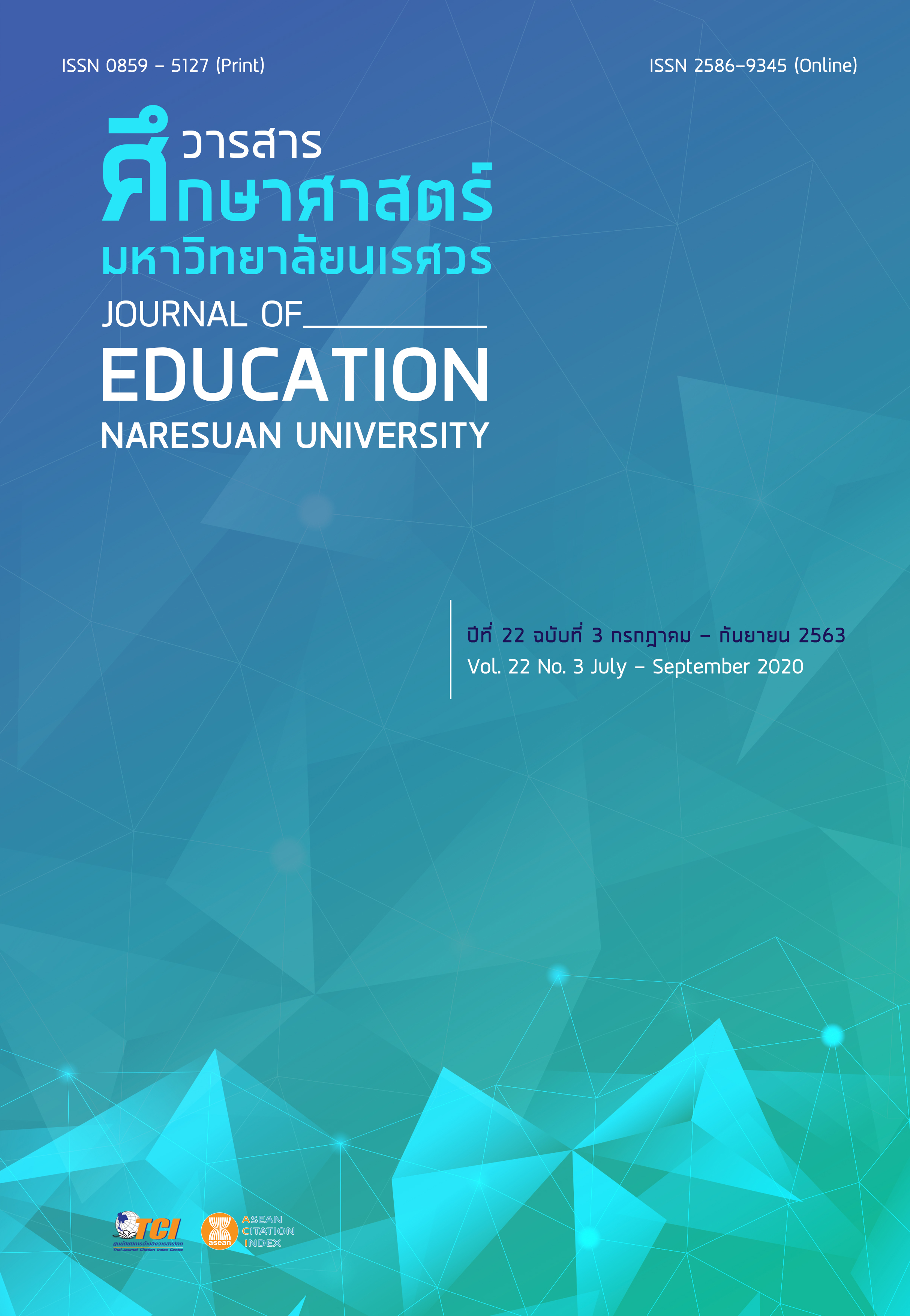A DEVELOPMENT OF LEARNING MANAGEMENT MODEL BASED ON AUTHENTIC LEARNING WITH SCAFFOLDING TO ENHANCE CREATIVE THAI LANGUAGE WRITING ABILITY FOR UPPER SECONDARY STUDENTS การพัฒนารูปแบบการจัดการเรียนรู้ตามสภาพจริงร่วมกับการเสริมศักยภาพเพื่อเสริมสร้างความสามารถด้านการเขียนภาษาไทยเชิงสร้างสรรค์ สำหรับนักเรียนชั้นมัธยมศึกษาตอนปลาย
Main Article Content
Abstract
The purpose of this research was to develop the learning management model based on authentic learning with scaffolding to enhance creative Thai language writing ability for upper secondary students. The specific purpose of this research were 1) to examine the way to manage of learning management model, 2) to develop and assess quality of the learning management model, and 3) to study the results of using the learning management model by using the process of research and development. The selected samples was a class of Mathayomsuksa 6 students at Satit Banchetawan Municipal School by using cluster random sampling method. The research instruments were interviewing, the learning management model and the creative Thai writing examination. The data analysis was mean, standard deviation, independent t-test and content analysis. The results of the research were as follows:
1. The principle of authentic learning to enhance creative writing are 1) Context-based learning. 2) Learning by doing and problem solving. 3) Co-operative learning. The principle of scaffolding to enhance creative writing consists of 1) learning interaction, 2) interactive learning, and 3) challenge task assignment for appropriate student development. 4) The ability supporting by giving various help. The ways to manage learning activities based on authentic learning and scaffolding for promoting the imagination are 1) using of meaningful context for stimulating learner thinking, 2) studying from good examples, 3) writing content and writing outline teaching, 4) writing real life story affected the learner feelings, 5) challenged thinking activities and free writing instruction, 6) classroom management, 7) specifying obvious learning style, 8) starts from the easy to the difficult situation, 9) using the divergent questions, and 10) stop helping when the learner can do by themselves.
2. The result of developing and accessing quality the model indicated as follows: 1) The learning management model developed by the researcher consisted of 5 components: principles, objectives, contents, teaching and learning process, assessment and evaluation. It was called SSR-CEE model: Survey the conceptual idea: S, Solve the real life problem: S, Research into Clarity: R, Creative writing: C, Examine the product: E, Evaluation and reflection to apply to the real world: E. It had high levels of appropriateness. 2) The effectiveness index of learning management model is equal to 0.6051.
3. The result of the experiment of the learning management model indicated as follows: 1) The students improved their ability of creative Thai language writing after they learned by using the model in every indications. 2) The ability of creative Thai language writing of students after learning with the model were higher than before learning at .05 level. 3) The students had the ability of creative Thai language writing higher than 70 percent criterion at the .05 level.
Article Details
The owner of the article does not copy or violate any of its copyright. If any copyright infringement occurs or prosecution, in any case, the Editorial Board is not involved in all the rights to the owner of the article to be performed.
References
Chiwaphan, A. (2011). Creative writing activity in Primary. Bangkok: Chulalongkorn University Press. [in Thai]
Eggen, P., & Kauchak, D. (1997). Educational psychology: Windows on classrooms (3rd ed.). Upper Saddle River, NJ: Merrill.
Joyce, B., & Weil, M. (1996). Model of teaching (5th ed). Boston: Allyn and Bacon.
Khammani, N. (2012). Teaching Science: Knowledge for effective learning management. Bangkok: Chulalongkorn University Publisher. [in Thai]
Ministry of Education. (2009). Learning standards and indicators of Thai language according to the Basic Education Core Curriculum B.E. 2551 (A.D. 2008). Bangkok: Bureau of Academic Affairs and Educational Standards. [in Thai]
Mongkonrat, T., Kaewurai, W., Kijkuakul, S., & Vibulrangson, S. (2012). A development of an instructional model focused on competency-based learning Thai language reading and writing for Mathayomsuksa 1 student. Journal of Education Naresuan university, 14(Special edition), 35-46. [in Thai]
National Institute of Educational Testing Service. (2015). Ordinary National Educational Test Manual
(O-NET). Bangkok: National Institute of Educational Testing Service. [in Thai]
Newmann, F. M., & Wehlage, G. G. (1993). Five standards of authentic instruction. Educational Leadership, 50(7), 8-12.
Nikitina, L. (2011). Creating an authentic learning environment in the foreign language classroom. International Journal of Instruction, 4(1), 33-46.
Seethong, P., Kaewurai, W., Wattanathorn, A., & Onthanee, A. (2016). The development of an instructional model based on collaborative learning with scaffolding to enhance Thai communicative writing ability for Prathomsuksa IV students. Journal of education Naresuan university, 18(4), 69-85. [in Thai]
Smith, J. A. (1973). Creative teaching of the language art in the elementary school. Boston: Allyn and Bacon.
Thaiubon, D. (2011). Thai writing skill (7th ed.). Bangkok: Chulalongkorn University Press. [in Thai]
Vygotsky, L. S. (1978). Mind in society: The development of higher psychological processes. Cambridge, MA: Harvard University Press.


